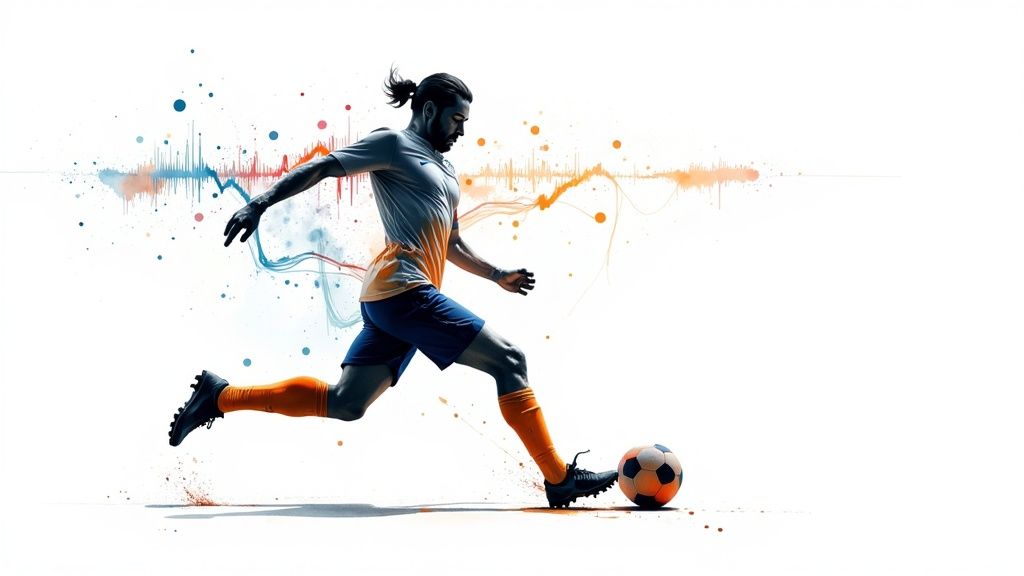
Predictive Analytics in Sports Winning With Data
Imagine a coach, clipboard in hand, but instead of just gut feelings, they’re looking at a data-driven forecast for the next game. That’s the real core of predictive analytics in sports. It’s not some magic crystal ball; it's a practical, powerful tool for making smarter calls by digging into past patterns to see what's likely to happen next.
So, What Is Predictive Analytics in Sports Anyway?
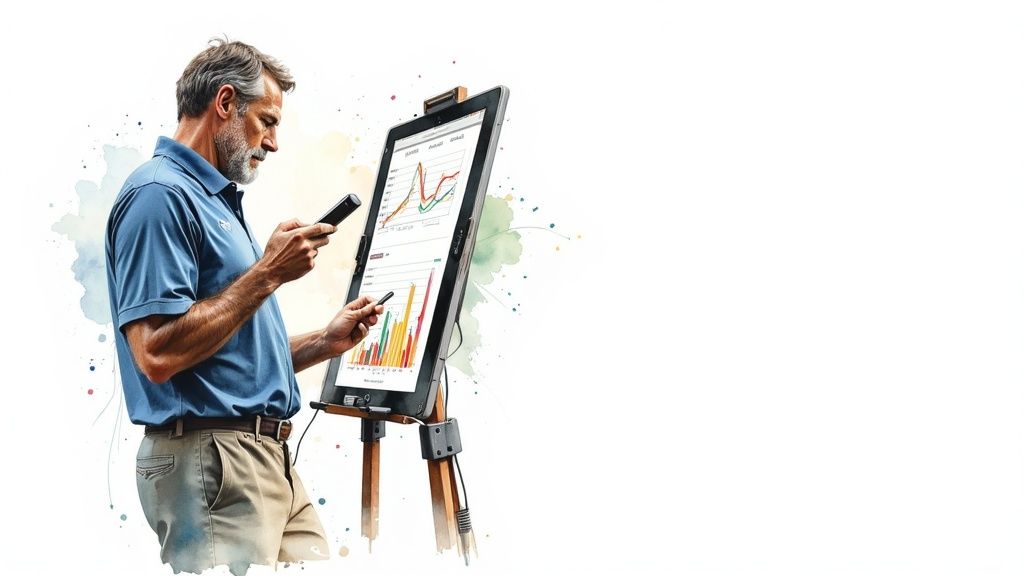
Think of it as a highly sophisticated weather report, but for the world of sports. Predictive analytics uses a mix of historical data, statistical algorithms, and machine learning to figure out the likelihood of future outcomes. Instead of forecasting rain, it's forecasting game results, a player's performance, or even the odds of an injury.
It all starts with gathering massive amounts of information. We’re talking everything from a quarterback's passing accuracy on third down to a tennis player's serve speed on different court surfaces. By feeding all this data into a predictive model, teams can finally move beyond simple averages and start spotting the subtle patterns that give them a real strategic edge.
From Raw Data to Winning Insights
The real magic here is the ability to answer specific, high-stakes questions. It’s not just about knowing a player scored 20 points last game. It’s about predicting how many points they're likely to score against a very specific defensive lineup. The applications are incredibly diverse and are changing the game.
- Game Outcome Prediction: Digging into team strengths, weaknesses, and historical matchups to forecast a final score.
- Individual Performance: Forecasting a player's key stats, like goals scored or yards gained, based on their current condition and who they're up against.
- Injury Prevention: Flagging players who are at high risk of injury by monitoring their workload, biomechanics, and fatigue levels.
This is a fundamental shift in how teams prepare. Using machine learning, teams can predict game outcomes and player performance with a surprisingly high degree of accuracy. In football, for instance, models can analyze player motions and past plays to suggest better formations and smarter tactical calls. You can get a deeper look at how teams are using these insights over at Data Sports Group.
The Big Idea: Predictive analytics isn’t about knowing the future with 100% certainty. It’s about calculating probabilities to dial down the uncertainty, leading to better, more informed decisions that ultimately stack up to more wins.
This whole analytical approach lets teams be proactive instead of reactive. Coaches and managers can tweak training to head off injuries before they happen, design game plans that exploit an opponent's hidden weakness, or make smarter in-game substitutions. It transforms data from a simple record of what happened into a roadmap for what to do next.
How Predictive Models Help Teams Win
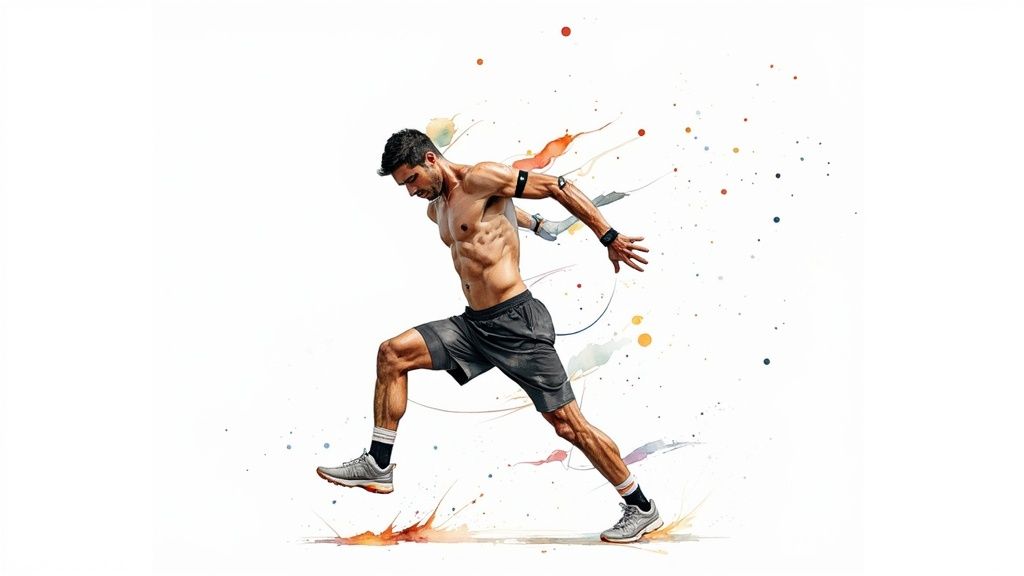
Predictive analytics isn't about looking in the rearview mirror; it's about actively mapping out how to win the next game. These models are practical tools that turn a mess of data into a real strategic advantage on the court, field, or ice.
Building a model is a lot like creating a detailed recipe. You need the right ingredients (data), a clear method (an algorithm), and a specific goal in mind (the prediction).
Two of the most common models you'll encounter in sports are regression and classification. Think of regression as forecasting a specific number, like how many points a player is expected to score. Classification, on the other hand, is simpler, it predicts a category, like a straight-up "win" or "loss."
Pinpointing Specific Advantages
The real magic of predictive analytics in sports lies in its specificity. It’s one thing to know a batter has a good average. It’s another thing entirely to predict how that same batter will perform against a lefty known for a wicked curveball. That level of detail changes everything.
- Basketball Example: A team might analyze thousands of shot charts to find out their opponent's defense is 15% less effective at stopping a corner three-pointer after a specific screen is set. The game plan then becomes simple: create more of those exact plays.
- Soccer Example: A team could model an opponent's passing patterns to predict which zones they’ll likely attack from. This lets defenders shift proactively, cutting off passing lanes before a real threat even develops.
These are the kinds of insights that are shaping the modern sports industry. If you have the skills to build and interpret these models, teams are looking for you. You can check out current openings for analytics pros on job boards like www.sportsjobs.online to see what’s out there right now.
From Data Model to Game Plan
The ultimate goal is to forge a direct link between a data model and a winning strategy. When a model works, it doesn't just spit out a statistic. It gives coaches an actionable instruction they can use to make smarter decisions.
The greatest value of a predictive model isn't just its accuracy. It's the ability to answer a question the coaching staff didn't even know to ask. It can uncover hidden patterns in an opponent's behavior or highlight a player's untapped potential in very specific situations.
For example, a football team's model might reveal that their star receiver has a much higher catch probability on plays run from a no-huddle offense. That insight immediately informs the offensive coordinator's play-calling in crunch time.
This is what turns data from a curious observation into a concrete path to victory. It's the very heart of modern sports strategy.
Protecting Players with Injury Prediction
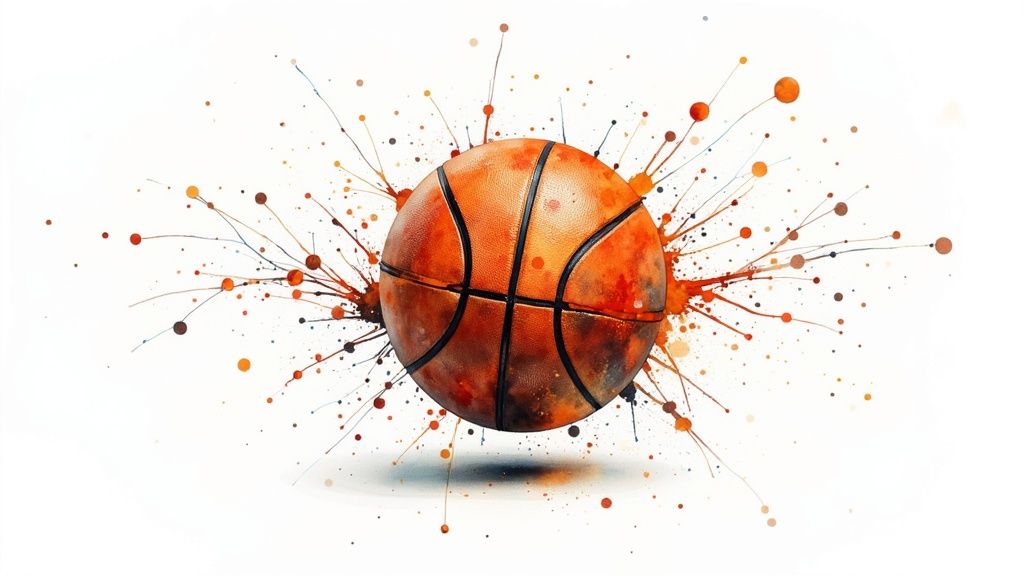
Predicting game scores is fun, but one of the most important jobs for analytics in sports today is keeping athletes healthy and on the field. It’s a simple truth: your best players can't help you win if they're stuck on the sidelines. This is where data steps up to protect a team's most valuable assets.
You've probably seen them, modern athletes are often covered in sensors. Wearable tech, from GPS vests tucked into their jerseys to biometric monitors, creates a constant stream of information. These devices track everything from heart rate and body temperature to the brutal acceleration and deceleration forces a player endures during a tough practice.
This flood of data is the fuel for injury prediction models. By constantly analyzing these numbers, specialized software can spot the early warning signs of fatigue or excessive strain. Think of it as an early detection system for the human body, flagging potential problems days or even weeks before a player feels a thing.
Turning Data into Preventative Action
So, what happens when a model flags a player as being in a high-risk zone? The coaching and medical staff can step in immediately. This isn't about guesswork; it's about making a data-backed decision to intervene before something goes wrong.
The intervention could be simple. It might mean adjusting a player’s training load for the week, scheduling an extra rest day, or zeroing in on specific recovery therapies.
This proactive approach completely flips the script on how teams manage player health. Instead of just reacting to injuries after they happen, organizations can actively work to prevent them from ever occurring. This doesn't just keep star players in the lineup, it can extend their entire careers.
By monitoring player load and biometric feedback, some professional teams have reported reductions in soft-tissue injuries by over 50%. This shows a clear, direct link between predictive analytics and keeping players available.
The ability to translate complex biometric data into a clear, actionable health plan is a golden ticket in today's sports world. The field of sports science is booming, and professionals who can build and manage these systems are in extremely high demand. If the idea of working at the intersection of data and peak human performance gets you excited, you can find roles where these exact skills are needed at www.sportsjobs.online.
Scouting the Next Generation of Talent
The same principles apply to finding future stars. Predictive analytics is reshaping how teams scout for talent by analyzing the performance data of young athletes. The models can help project a player's potential career trajectory, allowing scouts to spot prospects who might be completely undervalued by traditional eye tests.
Of course, predicting player health or game outcomes is never going to be 100% perfect, but it provides a massive edge. Research from the MIT Sloan Sports Analytics Conference found that certain models can predict game results with up to 74% accuracy, a huge leap over traditional expert predictions. This allows teams to better understand the odds and make smarter strategic decisions.
This level of insight is what empowers a Director of Strategy & Analytics to make the kind of impactful, data-informed choices that define a winning organization.
The Technology Powering Sports Predictions
So, what’s actually humming away behind the scenes to make these powerful sports predictions a reality? It’s not some single, magical piece of software. It’s a whole toolkit, a tech stack, of hardware and software all working in sync. This is the engine that turns raw data into the insights that are changing the game.
It all starts with getting the data. Teams use a whole host of tools to capture every possible detail they can about what happens on the field or court.
How Data Is Collected
We’re talking about a firehose of information coming from multiple sources. Each one tells a different part of the story.
- Optical Tracking Cameras: Think of systems like Hawk-Eye or SportVU. These cameras are mounted high above the action, tracking the real-time position of every player and the ball, dozens of times per second. This gives analysts incredibly rich spatial data to work with, perfect for studying formations, player spacing, and tactical execution.
- GPS Vests: You’ve probably seen players wearing these. They look like sports bras worn over their jerseys. These vests are packed with sensors that track metrics like total distance covered, top sprint speeds, and the number of accelerations and decelerations. This is gold for managing player workload and preventing fatigue-related injuries.
- Biometric Sensors: These wearables get even more personal, measuring internal data points like heart rate, breathing rate, and even core body temperature. This gives a direct window into how an athlete's body is responding to the stress of training and competition.
The methods for gathering this information are always evolving. Here’s a quick look at some of the most common data sources and what they’re used for.
Data Sources in Sports Analytics
| Data Source | Type of Data | Primary Use Case |
|---|---|---|
| Optical Tracking | Positional (X,Y coordinates), Ball/Player Speed | Tactical analysis, shot charts, player movement patterns |
| Wearable GPS | Physical Output (Distance, Sprints, Acceleration) | Workload management, fitness tracking, injury prevention |
| Biometric Sensors | Physiological (Heart Rate, Skin Temperature) | Monitoring physical strain, recovery analysis, performance readiness |
| Scout Reports | Qualitative (Strengths, Weaknesses, Tendencies) | Subjective player evaluation, opposition scouting, draft analysis |
| Play-by-Play Logs | Event-Based (Pass, Shot, Foul, Turnover) | Game-flow analysis, basic box score stats, player efficiency |
Each source provides a unique piece of the puzzle, and when combined, they create a comprehensive picture of performance.
The Brains Behind the Operation
Once you have this mountain of data, you need a way to make sense of it. That’s where machine learning (ML) and artificial intelligence (AI) come into play. These are the algorithms that can sift through millions of data points and spot hidden patterns that no human analyst could ever find on their own. They are the true core of predictive analytics in sports.
To build and run these models, analysts rely on a few key programming languages. Python is the king of the hill right now, mostly because of its amazing libraries for data science like Pandas, NumPy, and Scikit-learn. R is another favorite, especially for people coming from a statistics background, as it has fantastic tools for statistical modeling.
Just look at the impact this can have. The infographic below shows what happens when a team fully commits to an analytics-first approach.
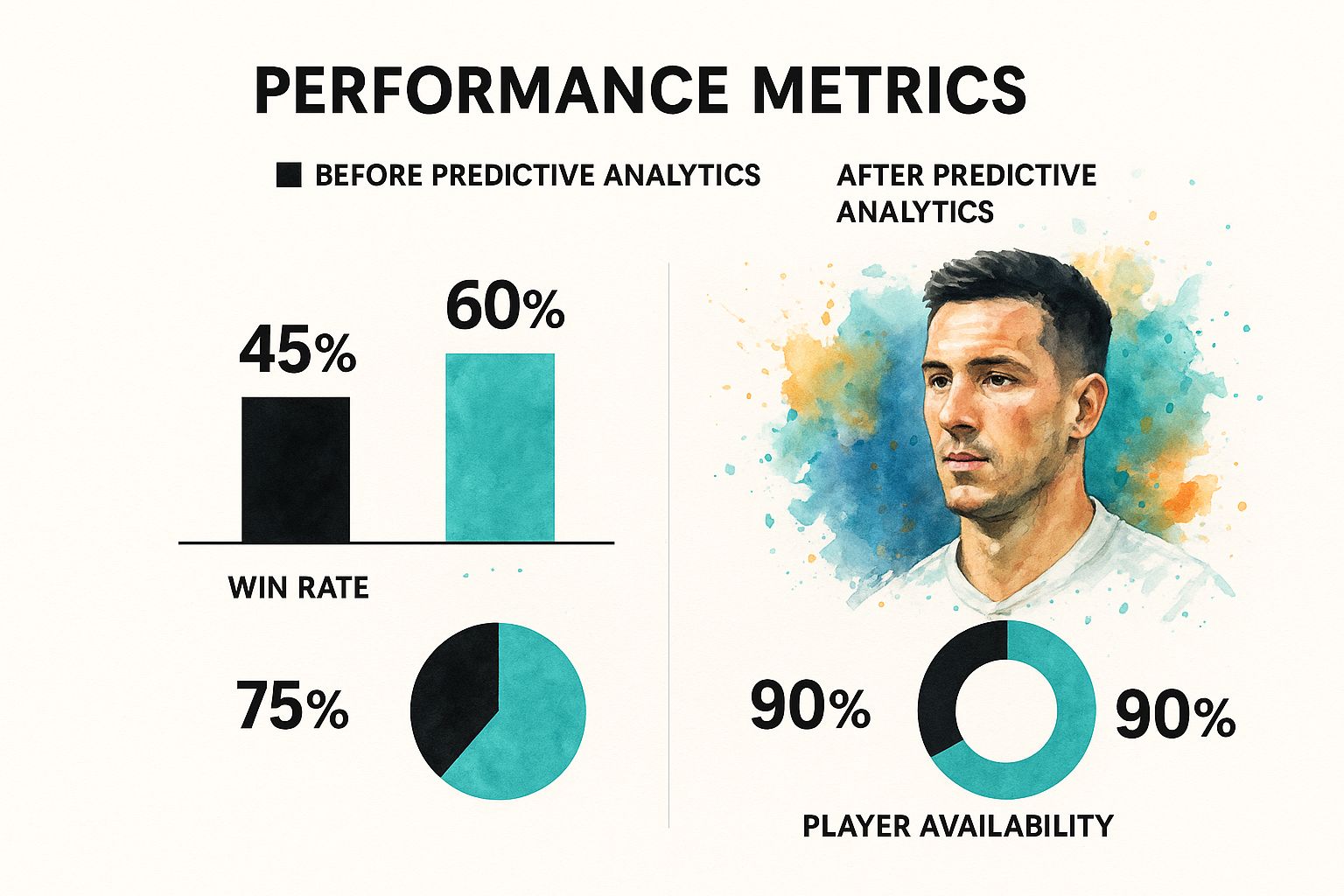
The results speak for themselves. The win rate jumps from 45% to 60%, and player availability, a key metric reflecting health and injury prevention, leaps from 75% to 90%. That’s a massive, tangible improvement.
Making the Data Make Sense
At the end of the day, a brilliant model is useless if the coach can't understand its output. The final step is translating complex findings into something clear and actionable. This is the job of data visualization.
Tools like Tableau and Power BI are essential here. They allow analysts to turn messy spreadsheets and confusing model outputs into clean, interactive dashboards and charts that a coach or GM can understand in seconds.
A model's prediction is only useful if it can be understood and trusted by the decision-makers. Great visualization bridges the gap between the data scientist and the coach, turning a complex finding into a simple, compelling story.
This entire tech stack, from the sensor to the screen, is what makes modern sports analytics possible. Getting comfortable with these tools is a must for anyone who wants to build a career in this space. If you're looking to break in, a great place to see what skills are in demand is www.sportsjobs.online, where you can find roles that require this exact expertise.
Building a Career in Sports Analytics
Predictive analytics in sports isn't just some clever new tactic, it’s now a full-blown, fast-growing industry. The business side of sports data is expanding like crazy, opening up a whole new world of opportunities for people passionate about both sports and tech.
The numbers don't lie. The global sports analytics market is seeing massive investment as more teams jump on the predictive modeling bandwagon. In 2023, the market was valued at around $5.43 billion, and forecasts show it could explode to $29.36 billion by 2034. You can dig deeper into these trends in the full report from Precedence Research.
Key Roles in the Sports Analytics Field
This explosive growth means new jobs are popping up every season. Teams are building out entire departments dedicated to data. Here are a few of the core roles that are in seriously high demand:
- Data Scientist: This is the heart of the operation. A data scientist designs and builds the predictive models that forecast everything from player performance to game outcomes.
- Performance Analyst: These pros focus squarely on player data from wearables and tracking systems. Their goal is to optimize training loads and, crucially, prevent injuries.
- Biomechanist: A specialist who studies the physics of how athletes move, using data to fine-tune technique and slash the risk of strain and injury.
As organizations lean more heavily on data, the demand for professionals who can turn complex datasets into winning strategies is soaring. A great analyst doesn't just present numbers; they tell a story that coaches and executives can actually use.
Ready to turn your passion into a career? If you've got the skills to wrangle data, now is the time to get in the game. You can start your search for the perfect role over at www.sportsjobs.online, the number one platform for finding careers in the sports industry.
What Teams Are Looking For
The most successful teams are hunting for people who can connect the dots between deep technical knowledge and a genuine love of the sport. You have to understand the nuances of the game to ask the right questions of the data. For example, knowing the difference between a zone and man-to-man defensive scheme is critical if you want to build a model that's actually useful.
This blend of skills is exactly what front offices want for advanced positions, especially those focused on machine learning. It's worth checking out what a high-level role looks like by peeking at this listing for a Senior Producer in Machine Learning. It really shows how specialized and important these jobs have become.
The path from being an enthusiast to a professional is clearer than ever before.
Common Questions About Sports Analytics
As predictive analytics gets more and more buzz in the sports world, it naturally stirs up a lot of questions. People want to cut through the hype and understand what this all really means for the games they love. Let's tackle some of the most common points of confusion head-on.
We'll get into the nitty-gritty of how accurate these predictions actually are, explore how modern data really works with old-school scouting, and lay out the skills you genuinely need to build a career in this exciting field.
How Accurate Are Sports Predictions Really?
This is usually the first thing people ask, and the honest answer is: it depends. The accuracy can swing quite a bit depending on the sport and, of course, the quality of the model you're using. For games with a ton of scoring and constant action, like basketball, some models can nail game outcomes with over 70% accuracy. But here's the thing: perfection isn't the goal.
The real aim of predictive analytics isn't to be a flawless crystal ball. It's about gaining a consistent edge. Even a tiny bump in accuracy, say, being just 5% better than what traditional methods or the betting markets suggest, can add up to several more wins over a long season. It’s a tool for making smarter, more informed decisions when the pressure is on, not for seeing the future with 100% clarity.
The true value isn't in being right every single time. It's about being right more often than the competition. Over a 162-game baseball season or an 82-game basketball season, that small statistical advantage adds up to a significant competitive difference.
This is what makes the field so compelling. It's a game of inches, both on the field and in the data.
Does Analytics Replace Coaches and Scouts?
Absolutely not. It makes them better. The most successful, forward-thinking teams are the ones that have figured out how to blend new-school analytics with old-school expertise. Think of it as a partnership, not a replacement.
Predictive analytics gives you objective, data-driven insights that can spot patterns the human eye would just miss. A model might flag a subtle defensive weakness that even a seasoned scout wouldn't notice. But data has its limits. A spreadsheet can't tell you about a player's leadership, their work ethic, or how they'll handle a do-or-die moment.
That’s where great coaches and experienced scouts are irreplaceable. They take their invaluable gut feelings and years of experience and combine them with the insights from their data team. The result is a much fuller, more complete picture that leads to smarter decisions. Analytics empowers human expertise; it doesn't make it obsolete.
What Skills Do I Need for a Career in Sports Analytics?
Breaking into this field takes a unique mix of technical chops and real sports smarts. You can't just be a numbers person or just a sports fan; you really have to be both. If you're serious about chasing a career in this growing industry, you should definitely check out the latest opportunities and skill requirements on www.sportsjobs.online.
On the technical side, you need a strong foundation. Here are the core skills teams are looking for:
- Statistics and Math: You have to really understand statistical concepts like regression, probability, and hypothesis testing. No way around it.
- Programming Languages: Being proficient in Python or R is non-negotiable. These are the tools of the trade for data work and building machine learning models.
- Database Knowledge: Knowing SQL is critical. You'll need it to pull and clean the raw data you'll be working with every day.
- Data Visualization: It's key to be able to use tools like Tableau or Power BI. Your job is to communicate your findings to people who aren't data experts, like coaches and GMs.
But technical skills are only half the story. The "soft skills" are just as crucial. You need a deep, authentic understanding of the sport you're analyzing to give the numbers meaningful context. You also need top-notch communication skills to explain complex data findings in a way that's simple, clear, and persuasive. For more on what the day-to-day grind is really like, you can read also about what a sports data analyst does.
At Sportsjobs Online, we connect talented analysts and data scientists with the teams and companies that are defining the future of sports. If you're ready to turn your passion for data and sports into a profession, explore the latest job openings on our site. Find your next challenge at https://www.sportsjobs.online and start your career today.
Hundreds of jobs are waiting for you!
Subscribe to membership and unlock all jobs
Sports Analytics
We scan all major sports and leagues
Updated Daily
New jobs are added every day as companies post them
Refined Search
Use filters like skill, location, etc to narrow results
Alerts
You can get daily alerts in your email for a specific search
Access to job postings from top teams and companies
Daily updates and notifications based on your preferences
🎯 Over 90% of customers chose to renew their subscriptions after the initial sign-up
Monthly
$6.99
per month
✓ Flexible monthly billing
✓ Unlimited access to all jobs
✓ Advanced filtering tools
✓ Daily job alerts
✓ Exclusive discount codes
✓ Cancel anytime
BEST VALUE
Yearly
$39
per year • Only $3.25/mo
✓ Save 50% vs monthly
✓ Unlimited access to all jobs
✓ Advanced filtering tools
✓ Daily job alerts
✓ Exclusive discount codes
✓ Cancel anytime
Lifetime
$59
one-time • forever
✓ Pay once, access forever
✓ Unlimited access to all jobs
✓ Advanced filtering tools
✓ Daily job alerts
✓ Exclusive discount codes
✓ Best long-term value